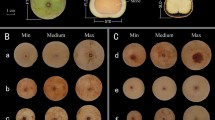Abstract
Fevillea is a small neotropical liana genus of the Cucurbitaceae that is well known ethnobotanically as having seeds with purgative and emetic properties. We report here the unusually high oil content of its seeds, first called to our attention by their use as candles by the Campa Indians in Amazonian Peru.Fevillea fruits apparently have a higher seed oil content than do those of any other dicotyledon. We suggest that, if the naturally occurring lianas in an uncut rainforest were all replaced byFevillea vines producing at normal levels, a per hectare oil yield comparable to those obtained in the most productive oil-seed plantations might be expected—without cutting a single tree. DifferentFevillea species have different seed-oil compositions and different ecological requirements, suggesting that appropriate breeding and agronomic development could lead to their use as new oil crops grown under a wide variety of tropical situations.
Similar content being viewed by others
Literature Cited
Anonymous. 1975. Underexploited Tropical Plants with Promising Economic Value. National Academy of Sciences, Washington, DC.
Ayensu, E. 1981. Medicinal Plants of the West Indies. Reference Publ. Algonac, MI.
Chisholm, M. J., and C. Y. Hopkins. 1967. Conjugated fatty acids in some Cucurbitaceae seed oils. Canad. J. Biochem. 45: 1081–1086.
Duke, J. A., and M. O. Bagby. 1982. Comparison of oilseed yields: a preliminary review.In Vegetable Oil Fuels. Proc. Int. Conf. Plant and Vegetable Oils as Fuels, p. 11–23. Amer. Soc. Agric. Engineers Publ. 4–82, St. Joseph, MI.
Eckey, E. W. 1954. Vegetable Fats and Oils. Reinhold, New York.
Emmons, L., and A. Gentry. 1983. Tropical forest structure and the distribution of gliding and prehensile-tailed vertebrates. Amer. Naturalist 121: 513–524.
Friese, F. W. 1931. Unknown essential oils from Brazilian plants used as anthelminthics. Perfumery Essential Oil Rec. 22: 370–371.
Garcia-Barriga, H. 1975. Flora Medicinal de Colombia 3: 272–273. Instituto de Ciencias Naturales, Universidad Nacional de Colombia, Bogota.
Gentry, A. H. 1979. Extinction and conservation of plant species in Tropical America: a phytogeographical perspective.In I. Hedberg, ed, Systematic Botany, Plant Utilization and Biosphere Conservation. Almqvist and Wiksell, Stockholm.
—. 1980. New species of Apocynaceae, Bignoniaceae, Passifloraceae, and Piperaceae from coastal Colombia and Ecuador. Phytologia 47: 97–107.
—. 1982. Patterns of neotropical plant species diversity. Evol. Biol. 15: 1–84.
—. 1983. Dispersal and distribution in Bignoniaceae. Sonderbd. Naturwiss. Ver. Hamburg 7: 187–199.
Girgis, P., and T. D. Turner. 1972. Lesser known Nigerian edible oils and fats. III. Fatty acid compositions as determined by gas-liquid chromatography. J. Sci. Food Agric. 23: 259–262.
Gunn, C. R., and J. V. Dennis. 1976. World Guide to Tropical Drift Seeds and Fruits. Demeter Press, New York.
Jamieson, G. S. 1943. Vegetable Fats and Oils. Ed. 2. Reinhold, New York.
Jeffrey, C. 1962a. Notes on Cucurbitaceae, including a proposed new classification of the family. Kew Bull. 15:337–371.
—. 1962b. Notes on some species ofFevillea L.,Siolmatra Baill., andPseudosicydium Harms (Cucurbitaceae) in the Amazon Basin. Kew Bull. 16: 199–202.
—. 1979. Further notes on Cucurbitaceae. IV. Some New-World taxa. Kew Bull. 33: 347–380.
Lindley, J., and T. Moore. 1870. The Treasury of Botany. Ed. 2. Longman, London.
Macbride, J. F. 1937. Cucurbitaceae.In Flora of Peru. Publ. Field Mus. Nat. Hist., Bot. Ser. 13: 321–383.
Núñez, M. E. 1975. Plantas Medicinales de Costa Rica y su Folclore. Universidad de Costa Rica, San Jose, Costa Rica.
Pérez-Arbeláez, E. 1937. Plantas Medicinales y Venenosas de Colombia. Edit. Cromos, Bogota.
—. 1947. Plantas utile de Colombia. Ed. 2. Imprenta Nacional, Bogota.
Pio Corr ea, M. 1931. Dicionario das Plantas úteis do Brazil 3: 33–35. Serviço de Informação Agrícola, Ministério da Agriculture, Rio de Janeiro.
Raven, P. H. 1976. Ethics and attitudes.In J. B. Simmons, R. I. Beyer, P. E. Brandham, G. L. Lucas, and V. T. H. Parry, ed, Conservation of Threatened Plants, p. 155–179. Plenum, New York.
Spruce, R. 1908. Notes of a Botanist on the Amazon and Andes. A. R. Wallace, ed. Macmillan, London.
Tulloch, A. P., and L. Bergter. 1979. Analysis of the conjugated trienoic acid containing oil fromFevillea trilobata by13C nuclear magnetic resonance spectroscopy. Lipids 14: 996–1002.
Uphof, J. C. T. 1968. Dictionary of Economic Plants. Ed. 2. Verlag Cramer, Würzburg.
Usher, G. 1974. A Dictionary of Plants Used by Man. Constable, London.
Williams, L. O. 1981. The useful plants of Central America. Ceiba 24: 1–342.
Author information
Authors and Affiliations
Rights and permissions
About this article
Cite this article
Gentry, A.H., Wettach, R.H. Fevillea-a new oil seed from Amazonian Peru. Econ Bot 40, 177–185 (1986). https://doi.org/10.1007/BF02859141
Received:
Accepted:
Issue Date:
DOI: https://doi.org/10.1007/BF02859141




